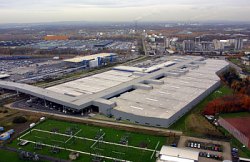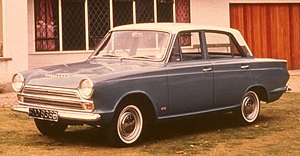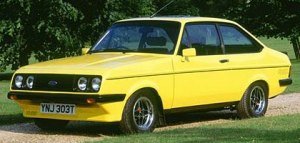
| - |
 Headquarters
in Cologne,
Germany.
Headquarters
in Cologne,
Germany.R&D centers: Cologne (Germany) (cars), Dunton (Essex of UK) (engines, transmission and vans)
Main plants:
Germany: Cologne (Fiesta), Saarlouis (Focus, C-Max, Kuga)
Belgium: Genk (Mondeo, S-Max / Galaxy)
Spain: Valencia (Fiesta, Focus)
2017: 1,562,100 units
2016: 1,539,000 units
2015: 1,530,000 units
2014: 1,387,000 units
2013: 1,360,000 units
2012: 1,353,000 units
2011: 1,602,000 units
2010: 1,573,000 units
2009: 1,568,000 units
2008: 1,820,000 units
2007: 1,854,000 units
2006: 1,496,000 units
2005: 1,785,000 units
Ford Europe is traditionally one of the top 6 car makers in Europe beside Volkswagen, Opel, PSA, Renault and Fiat.
The early European factories produced the same cars as in USA. When the Great Depression hit Europe in early 1930s, Ford Britain found it difficult to sell the large-engined Model A, which was too expensive to tax and run in Europe. Therefore it specially developed a 933cc Model Y for the local market. Since then the European Ford started developing its own models tailor-made for local needs.
 1962 Ford Cortina
1962 Ford CortinaAfter WWII, Ford Britain and Ford Germany emerged as the leaders of the European operations. They developed their own models and even competed with each other in other markets. The Britain produced Anglia, Consul / Zephyr and Cortina, while Germany produced the competing Taunus series.
Detroit finally realized the problem. In 1967 it merged all European operations into Ford of Europe, headquartered in UK. Britain and Germany still took the lead of product development, but in a coordinated way. Now the whole Europe is offered with the same Escort, Capri and new Cortina / Taunus.
 1976 Ford Escort (Mk2) RS2000
1976 Ford Escort (Mk2) RS2000In the following decades, Cologne gradually took the upper hand in the power game as the European continent market is much bigger than the UK. In the 1990s, the development of all cars, with the exception of Fiesta, had been moved to Cologne. Britain lost its power further in 1999 when the headquarters of Ford Europe also moved to Cologne. 3 years later, its Dagenham plant ceased car production. Since then the Britain was turned into a R&D and production base for engines and commercial vehicles.